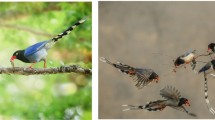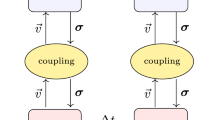Abstract
A morphing wing concept has been investigated over the last decade because it can effectively enhance aircraft aerodynamic performance over a wider range of flight conditions through structural flexibility. The internal structural layouts and component sizes of a morphing aircraft wing have an impact on aircraft performance i.e. aeroelastic characteristics, mechanical behaviors, and mass. In this paper, a novel design approach is proposed for synthesizing the internal structural layout of a morphing wing. The new internal structures are achieved by using two new design strategies. The first design strategy applies design variables for simultaneous partial topology and sizing optimization while the second design strategy includes nodal positions as design variables. Both strategies are based on a ground structure approach. A multiobjective optimization problem is assigned to optimize the percentage of change in lift effectiveness, buckling factor, and mass of a structure subject to design constraints including divergence and flutter speeds, buckling factors, and stresses. The design problem is solved by using multiobjective population-based incremental learning (MOPBIL). The Pareto optimum results of both strategies lead to different unconventional wing structures which are superior to their conventional counterparts. From the results, the design strategy that uses simultaneous partial topology, sizing, and shape optimization is superior to the others based on a hypervolume indicator. The aeroelastic parameters of the obtained morphing wing subject to external actuating torques are analyzed and it is shown that it is practicable to apply the unconventional wing structures for an aircraft.






















Similar content being viewed by others
References
ANSYS (2011) ANSYS mechanical APDL and mechanical applications theory references. http://www1.ansys.com/customer/content/documentation/130/ans_thry.pdf. Accessed 2011
Amadori K, Jouannet C, Krus P (2007) A framework for aerodynamic and structural optimization in conceptual design. Presented at the 25th AIAA applied aerodynamics conference, Florida, USA, 25–28 June 2007
Baluja S (1994) Population-based incremental learning: a method for integrating genetic search based function optimization and competitive learning. CMU_CS_95_163
Bandyopadhyay S, Saha S, Maulik U, Deb K (2008) A simulated annealing-based multiobjective optimization algorithm: AMOSA. IEEE Trans Evol Comput 12(3):269–283
Bendsøe MP, Ben-Tal A, Zowe J (1994) Optimization methods for truss geometry and topology design. Struct Optim 7:141–159
Bendsøe M, Sigmund O (2003) Topology optimization. Springer, Germany
Bureerat S, Sriworamas K (2007) Population-based incremental learning for multiobjective optimization. Advan Soft Comput 39:223–232
Bureerat S, Srisomporn S (2010) Optimum plate-fin heat sinks by using a multiobjective evolutionary algorithm. Eng Optim 42(4):305–323
Cooper JE (2007) Adaptive aeroelastic structures. In: Wagg D, Bond I, Weaver P, Friswell M (eds) Adaptive structures: engineering applications. Wiley, England, pp 136–162
Dardel M, Bakhtiari-Nejad F (2010) A reduced order of complete aeroelastic model for limit cycle oscillations. Aero Sci Tech 14:95–105
Deb K, Pratap A, Meyarivan T (2001) Constrained test problems for multi-objective evolutionary optimization. Lect Notes Comput Sci 1993:284–298
Eves J, Toropov VV, Thompson HM, Gaskell PH, Doherty JJ, Harris J (2009) Topology optimization of aircraft with non-conventional configurations. Presented at the 8th world congress on structural and multidisciplinary optimization, Lisbon, Portugal. 1–5 June 2009
Friedrich T, Horoba C, Neumann F (2009) Multiplicative approximations and the hypervolume indicator. Presented at the genetic and evolutionary computation conference (GECCO’09), Montréal. Cannada. 8–12 July 2009
Hall KC (1994) Eigenanalysis of unsteady flows about airfoil, cascades, and wings. AIAA J 32(12): 2426–2432
Harder RL, Desmarais RN (1972) Interpolation using surface splines. J Aircraft 9(2):189–191
Harzen LU, Peter H (2008) Multilevel optimization in aircraft structural design evaluation. Comput Struct 86(1/2):104–118
Inoyama D, Sander B, Joo J (2008) Topology optimization approach for the determination of the multiple-configuration morphing wing structure. J Aircraft 45(6):1853–1862
Intachub U, Bureerat S (2006) Aeroelastic analysis of an aircraft wing structure-the use of a discrete-time model. Presented at the 20th Conference of Mechanical Engineering Network of Thailand, Nakhon Ratchasima, Thailand. 18–20 October 2006
Katz J, Plotkin A (1991) Low-speed aerodynamics from wing theory to panel methods. MCgraw-Hill, Singapore
Kim JH, Kim YH, Choi SH, Park IW (2009) Evolutionary multiobjective optimization in robot soccer system for education. IEEE Comput Intell Mag 4(1):31–41
Kittipichai R (2006) Multidisciplinary design optimization of active aeroelastic aircraft structures. In the faculty of engineering and physical sciences. University of Manchester, Manchester, UK
Kittipichai R, Cooper JE (2006) Optimization of UAVs with adaptive internal structures. Presented at the 5th ASMO conference. Oxford, UK, p 2004
Krog L, Tucker A, Kemp M, Boyd R (2004) Topology optimization of aircraft wing box ribs. Presented at the 10th AIAA/ISSMO multidisciplinary analysis and optimization conference, New York, USA. 30 August–1 September, 2004
Kunakote T, Bureerat S (2011) Structural topology optimization using multiobjective evolutionary algorithms. Eng Optim 43(5):541–557
Lencus A, Querin OM, Steven GP, Xie YM (2001) Aircraft wing design automation with ESO and GESO. Int J Veh Des 28(3):98–111
Liu S, Ge W, Li S (2008) Optimal design of compliant trailing edge for shape changing. Chin J Aeronaut 21:187–192
Lee HT, Kroo IM, Bieniawski S (2002) Flutter suppression for high aspect ratio flexible wings using microflaps. Presented at the 43rd AIAA/ASME/ASCE/AHS/ASC structures, structural dynamics, and materials conference, Colorado, USA. 22–25 April 2002
Lerner E, Markowitz J (1979) An efficient structural resizing procedure for meeting static aeroelastic design objectives. J Aircraft 16(2):65–71
Lu KJ, Kota S (2003) Design of compliant mechanism for morphing structural shapes. J Intell Mater Syst Struct 14(6):379–391
Maute K, Allen M (2004) Conceptual design of aeroelastic structures by topology optimization. Struct Multidiscip Optim 27(1–2):27–42
Maute K, Reich GW (2006) Integrated multidisciplinary topology optimization approach to adaptive wing design. J Aircraft 43(1):253–263
Nantasenee S, Sleesongsom S, Bureerat S (2009) Comparing flutter analysis programs for low air-vehicles. Presented at the 23rd conference of mechanical engineering Network of Thailand, Chiang Mai, Thailand. 4–7 November 2009, (in Thai)
Pendelton E (2000) Back to the future: how aeroelastic wings are a return to aviation’s beginnings and a small step to future bird like wings. In: RTO ATV symposium on active control technology for enhanced performance operational capabilities of military aircraft, land vehicles and sea vehicles. Germany
Rao JS, Kiran S, Kamesh JV, Padmanabhan MA, Chandra S (2009) Topology optimization of aircraft wing. J Aero Sci Tech 61(3):402–414
Rothwell A (1991) Multi-level optimization of aircraft shell structures. Thin-Walled Struct 11(1/2):85–103
Saggere L, Kota S (1999) Static shape control of smart structures using compliant mechanisms. AIAA J 37(5):572–578
Saitou K, Izui K, Nishiwaki S, Papalambros P (2005) A survey of structural optimization in mechanical product development. Trans ASME 5:214–226
Sensmeier MD, Samareh JA (2004) A study of vehicle structural layouts in post-WWII aircraft. Presented at the 45th AIAA/ASME/ASCE/AHS/ASC structures, structural dynamics & materials conference, California, USA. 19–22 April 2004
Sleesongsom S, Bureerat S (2011) Effect of actuating forces on aeroelastic characteristics of a morphing aircraft wing. Appl Mech Mater 52–54:308–317
Sleesongsom S, Bureerat S (2013) New conceptual design of aeroelastic wing structures by multiobjective optimization. Eng Optim 45(1):107–122
Sofla AYN, Meguid SA, Tan KT, Yeo WK (2010) Shape morphing of aircraft wing: status and challenges. Mater Des 31(3):1284–1292
Stanford B, Ifju P (2009) Aeroelastic topology optimization of membrane structures for micro air vehicles. Struct Multidiscip Optim 38(3):301–316
Tang D, Dowell EH, Hall KC (1999) Limit cycle oscillation of a cantilevered wing in low subsonic flow. AIAA J 37(3):364–371
Wang W, Guo S, Yang W (2010) Simultaneous partial topology and size optimization of a wing structure using ant colony and gradient based methods. Eng Optim 43(44):433–446
Xu Y, Li S, Rong X (2005) Composite structural optimization by genetic algorithm and neural network response surface modeling. Chin J Aeroelast 18(4):310–316
Acknowledgments
The authors are grateful for the financial support provided by the Thailand Research Fund, the Royal Golden Jubilee Ph.D. Program and Chiangrai College.
Author information
Authors and Affiliations
Corresponding author
Rights and permissions
About this article
Cite this article
Sleesongsom, S., Bureerat, S. & Tai, K. Aircraft morphing wing design by using partial topology optimization. Struct Multidisc Optim 48, 1109–1128 (2013). https://doi.org/10.1007/s00158-013-0944-3
Received:
Revised:
Accepted:
Published:
Issue Date:
DOI: https://doi.org/10.1007/s00158-013-0944-3




